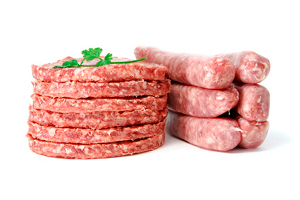One important factor in the ease of cutting into a sausage patty or the juiciness of a smoky link is mixing. For instance, the mixing process can have a tremendous effect on the texture of the finished product. Mixing is critical because the process achieves uniform distribution of fat and lean, attains good distribution of non-meat ingredients and extracts protein.

|
Mixing provides mechanical action to meat, which results in protein extraction.
“This protein extraction can occur with or without the presence of salt, water and phosphates, which enhance protein solubilization and extraction,” explains Lynn Knipe, associate professor at Ohio State University in Columbus, Ohio. “However, the mixing action also helps to disperse the non-meat ingredients more uniformly throughout the mixture to further increase the extraction of proteins from the meat.”
Whether non-meat ingredients are used during mixing of meat, or not, the extraction of proteins to the surface of the meat particles increases the protein-to-protein bind of the particles, which ultimately results in a tougher, more rubbery texture, he says. For cooked sausage, this protein extraction is desirable, however, for sausage patties or ground beef the rubbery texture resulting from the protein extraction is typically not considered desirable.
“Depending upon the traditional product characteristics of the product that we’re making, we may want to either minimize or maximize that protein extraction during mixing,” says Joe Cordray, extension meat specialist at Iowa State University in Ames, Iowa. “Of course the amount of proteins that we extract during mixing is directly proportioned to the amount of mechanical energy that we impart into the product during mixing, which is why there are different styles of mixers.”
Typically, paddle mixers are designed to minimize protein extraction, while some screw mixers are manufactured to work the product a little bit more for more protein extraction, Cordray says.
How much protein is extracted also is directly proportional to how long the product is mixed. For instance, if a processor is making a fresh pork sausage patty, one would want to minimize the extraction of protein, so that after the patty is cooked, the consumer can tear into it with a fork and it easily breaks apart. On the other hand, processors producing smoked sausage add water to the product that they want to bond during thermal processing to keep the end product juicy. This requires longer mixing for adequate protein extracted to bind that moisture during thermal processing, Cordray explains.
Achieving consistency
One of the top ways of maximizing sales is consistency of a product’s taste, which is partly attributed to mixing. Consistency is achieved by determining how long a product should be mixed for its desired characteristics and mixing it for the same amount every time.
“Whether it is non-meat ingredients, such as salt, spices, etc., or meat ingredients of different fat contents, consistency is very important for consistency of flavor and texture with each bite that a consumer takes,” Knipe says.
Maximizing the consistency of two ingredients will occur by longer mixing times, however, meat processors need to achieve a maximum consistency or uniformity in as short of a time period as possible, particularly if the meat mixture contains some fat. This is because longer mixing can result in temperature rise and damage to the fat cells, which can cause smearing during stuffing and “fatting out,” both undesirable quality defects, Knipe explains.
“All of this can be minimized by keeping the meat temperature cold during the mixing process, if that is possible,” he says. “In general, the goal is to maximize the uniformity of the mixing process, while minimizing damage to the meat.
“While some will debate this,” Knipe continues, “it is generally recognized that paddle mixers maximize the uniformity of mixing with less damage to the meat, compared to ribbon mixers. Overlapping and counter-rotating paddles are optimal for achieving consistency in mixing of meat ingredients.”
Cordray cautions that the mixer should match the batch size as well. When the batch is far less than or greater than a mixer’s capacity, it opens the door for poor mixing.
“A mixer has to be about 60 percent full in order for it to operate correctly,” he says. In addition, it is very important that mixing systems be well-maintained with regular checks for wear or other changes in the moving parts that might result in metal contamination to the meat that is being mixed. Unkempt mixers can affect the yield and the consistency of products.
“The interior of the mixer also needs to be highly polished to minimize meat temperature rise, from friction that can result from the meat sliding along the sides of the mixer,” Knipe says. Mixers are continuing to get more sophisticated in design to aid in the ease of cleaning as well, Cordray says.
“That’s kind of an ongoing challenge … to try to increase the sophistication of the equipment to minimize the harborage sites for microorganisms and to make them easier and easier to clean and maintain,” he says. In addition, the opportunity for more automation exists as far as loading and unloading the mixers, Cordray says.





Report Abusive Comment